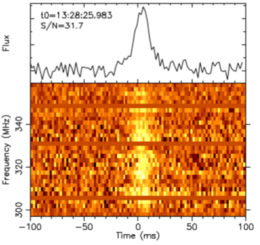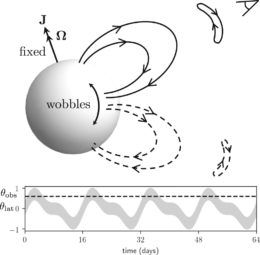Earlier this year, we gained new insight into the origins of fast radio bursts (FRBs) when FRB 180916 became the first of these strange sources observed to exhibit repeated bursts in a periodic pattern.
Now, we’re taking a look at four recent studies detailing some of the latest observations and theories of FRB 180916 — and what this tells us about the population of FRBs as a whole.
What Do We Already Know About FRB 180916?
FRBs are incredibly energetic bursts of radio waves that last just a few milliseconds and originate from extragalactic sources. We’ve detected more than 100 of them, and this number is growing rapidly. Yet despite these observations, we still don’t know what causes FRBs — though we have dozens of theories.

The location of FRB 180916 is in a galaxy’s spiral arm, marked with a green circle in this image from the Gemini-North telescope. [NSF’s Optical-Infrared Astronomy Research Laboratory/Gemini Observatory/AURA]
The intriguing source is FRB 180916, a repeating FRB that’s under 500 million light-years away. CHIME’s recent observations of FRB 180916 indicate that its activity is modulated by a 16.35-day period: its bursts fall within an active window of about 5 days, and then the source is quiet for about 11 days before restarting activity.
This new information is helping scientists narrow the possible explanations of what causes FRBs — but other recent observations have provided additional insight.
New Clues from Multiple Telescopes
In two new studies led by Maura Pilia (INAF Cagliari Observatory, Italy) and Pragya Chawla (McGill University, Canada), independent teams have now detected the lowest-frequency observations of radio bursts from FRB 180916 — or, indeed, of any FRB — yet.

A profile of one of the bursts from FRB 180916 detected by the Sardinia Radio Telescope. [Adapted from Pilia et al. 2020]
These observations tell us two main things:
- The environment surrounding the source of the bursts doesn’t significantly affect the emission we see.
- The lower-energy cutoff for the emission from FRB 180916’s bursting mechanism is lower than we thought it was — if there is even a cutoff at all!
These clues work to constrain the possible models of FRB sources — for instance, rendering the models that predict dense environments around the source, such as young supernova remnants, unlikely. Some models still seem highly plausible, however — and highly magnetized neutron stars are looking especially appealing.
Analyzing a Plausible Explanation
Two independent theoretical studies — one by J.J. Zanazzi (CITA, University of Toronto) and Dong Lai (Cornell University and UC Berkeley), and the other by a team of researchers led by Yuri Levin (Columbia University, Flatiron Institute; Monash University, Australia) — recently focused on the picture of a lone, spinning neutron star threaded with a strong magnetic field.

Schematic showing how a precession-driven wobble of a magnetar can lead to magnetic flares that move in and out of our line of sight. [Levin et al. 2020]
This picture is consistent with the periodic radio emission we’ve detected thus far. What’s more, we may be able to test this theory soon, since magnetized neutron stars are expected to gradually spin slower over their lifetimes. If such an object is the source of FRB 180916, then we’d expect to see a detectable increase in the periodic modulation of the bursts within a year.
There’s still work to do, but with growing observations — and the possibility now of exploring at even lower frequencies — it’s exciting to watch our progress toward an explanation for these mysterious bursts!
Citation
“Detection of Repeating FRB 180916.J0158+65 Down to Frequencies of 300 MHz,” P. Chawla et al 2020 ApJL 896 L41. doi:10.3847/2041-8213/ab96bf
“The Lowest-frequency Fast Radio Bursts: Sardinia Radio Telescope Detection of the Periodic FRB 180916 at 328 MHz,” M. Pilia et al 2020 ApJL 896 L40. doi:10.3847/2041-8213/ab96c0
“Periodic Fast Radio Bursts with Neutron Star Free Precession,” J. J. Zanazzi and Dong Lai 2020 ApJL 892 L15. doi:10.3847/2041-8213/ab7cdd
“Precessing Flaring Magnetar as a Source of Repeating FRB 180916.J0158+65,” Yuri Levin et al 2020 ApJL 895 L30. doi:10.3847/2041-8213/ab8c4c

11 Comments
Pingback: From AAS NOVA: “An Update on the Mysterious Flashes of FRB 180916” | sciencesprings
Pingback: Új adatok egy rejtélyes rádiókitörésről – Könyv Kuckó
Pingback: Singularity-less Dark Stars to Replace Our Black Hole Model? - Sapiens Digital
Pingback: Singularity-less "Dark Stars" Suggest We Might Be Mistaken About Black Holes »
Pingback: „Ciemne gwiazdy” bez osobliwości Może zastąpić nasz model czarnych dziur
Pingback: Singularity-less Dark Stars to Replace Our Black Hole Model? – JWEasyTech
Pingback: 535 new fast radio bursts help answer deep questions about the universe and shed light on these mysterious cosmic events
Pingback: 535 new fast radio bursts help answer deep questions about the universe and shed light on these mysterious cosmic events - Techbondhu News
Pingback: To Shed Light On These Mysterious Cosmic Events, 535 New Fast Radio Bursts Help Answer Deep Questions About The Universe
Pingback: 535 new fast radio bursts help answer deep questions about the universe and shed light on these mysterious cosmic events – Cowboy.News
Pingback: Lake County News,California – Space News: 535 new fast radio bursts help answer deep questions about the universe and shed light on these mysterious cosmic events | Out of This World